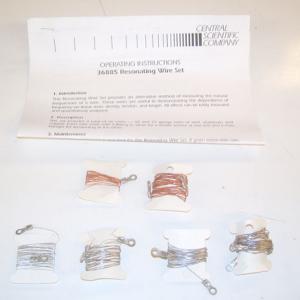College of Liberal Arts & Sciences
3B22.14 - Standing Waves in a Wire
Connect the wave generator directly to the wire, and amplify the signal if necessary. Or, you can also use the Mechanical Oscillator. Run an AC signal of low frequency ( 0 to 1000 Hz.) through the wire or Oscillator. As a magnet is brought near one end of the wire, standing waves will appear. Adjust the frequency or wire tensions to achieve maximum amplitude.
- Ray Scott Wakeland and Bennet Brabson, "Wave Speed on a String Revisited", TPT, Vol. 28, # 1, Jan. 1990, p. 57.
- J.W. Jewett, J.V. Spadaro, "Vibrating String Resonance Spectra on the Oscilloscope", AJP, Vol. 50, # 6, June 1982, p. 570.
- H. G. Hornung and M. J. Durie, "Stiffness Corrections for the Vibration Frequency of a Stretched Wire", AJP, Vol. 45, # 10, Oct. 1977, p. 991.
- J. Morris Blair, "A Variaiton on Melde's Experiment", AJP, Vol. 38, #11, Nov. 1970, p. 1317.
Disclaimer: These demonstrations are provided only for illustrative use by persons affiliated with The University of Iowa and only under the direction of a trained instructor or physicist. The University of Iowa is not responsible for demonstrations performed by those using their own equipment or who choose to use this reference material for their own purpose. The demonstrations included here are within the public domain and can be found in materials contained in libraries, bookstores, and through electronic sources. Performing all or any portion of any of these demonstrations, with or without revisions not depicted here entails inherent risks. These risks include, without limitation, bodily injury (and possibly death), including risks to health that may be temporary or permanent and that may exacerbate a pre-existing medical condition; and property loss or damage. Anyone performing any part of these demonstrations, even with revisions, knowingly and voluntarily assumes all risks associated with them.
